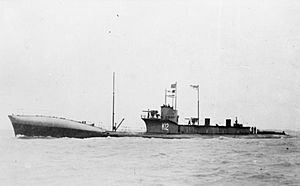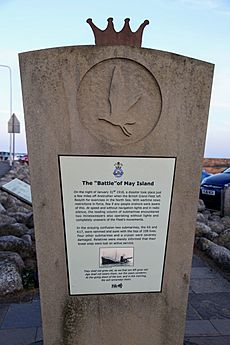Battle of May Island facts for kids

The bow of the drydocked cruiser HMS Fearless after colliding with the submarine K17
|
|
| Date | 31 January – 1 February 1918 |
|---|---|
| Location | Waters off the Isle of May |
| Also known as | Operation E.C.1 |
| Type | Naval accident |
| Cause | Human Error, Weather, Mechanical Failure |
| Participants | |
| Outcome |
|
| Deaths |
|
| Property damage | |
The Battle of May Island was a series of terrible accidents that happened during a naval exercise called Operation E.C.1 in 1918. It is named after the Isle of May, a small island near the Firth of Forth in Scotland. This "battle" was not a fight against an enemy. Instead, it was a chain of unfortunate collisions between Royal Navy ships. These ships were traveling from Rosyth, Scotland, to take part in a large exercise in the North Sea.
On a foggy night between January 31 and February 1, 1918, five collisions took place. Eight ships were involved in these accidents. Two K-class submarines were lost, and four other submarines were damaged. A light cruiser also suffered damage. In total, 105 British sailors tragically died during these events.
Contents
Why Was It Called a "Battle"?
Calling these events a Battle of May Island is a sad joke. It's an example of black humour, which is when people find humor in very dark or serious situations. Even though these accidents happened during First World War, no enemy forces were involved. All the losses were completely accidental.
What Was Operation E.C.1?
On the afternoon of January 31, 1918, about 40 naval ships left Rosyth in Scotland. They were heading to Scapa Flow in Orkney. A huge exercise involving the entire Grand Fleet was planned for the next day.
The ships included:
- Three battleships with their destroyer escorts.
- Four battlecruisers with their destroyers.
- Two cruisers.
- Two groups (called flotillas) of K-class submarines. Each group was led by a surface warship.
The K-class submarines were very large for their time. They were about 339 feet (103 meters) long. These submarines were special because they used steam turbines. This allowed them to travel at 24 knots (about 27 miles per hour) on the surface. This speed helped them keep up with the faster battle fleet.
The two submarine groups were:
- The 12th Submarine Flotilla: This group included K3, K4, K6, and K7. They were led by Captain Charles Little in the light cruiser HMS Fearless.
- The 13th Submarine Flotilla: This group had K11, K12, K14, K17, and K22. They were led by Commander Ernest William Leir in the destroyer HMS Ithuriel.
These K-class submarines had been moved to Rosyth in December 1917. This was done to place them in a better spot for their missions.
The Timeline of Accidents
Setting Sail in the Dark
At 6:30 PM, all the ships started moving. The entire fleet, led by Vice Admiral Sir Hugh Evan-Thomas in the battlecruiser HMS Courageous, sailed in a single line. This line was almost 30 miles (48 km) long.
- The Courageous was at the very front.
- Behind it was Ithuriel, leading the 13th Submarine Flotilla.
- Several miles back came the battlecruiser squadron. This included HMAS Australia, HMS New Zealand, Indomitable, and Inflexible with their destroyers.
- After them was the 12th Submarine Flotilla.
- Bringing up the rear were three battleships with their screening destroyers.
The ships started at 16 knots (18 mph). But Admiral Evan-Thomas ordered them to speed up to 22 knots (25 mph) when they passed the Isle of May. This island was right at the entrance to the Forth estuary.
All vessels were told to sail one behind the other. They were to keep about 400 yards (366 meters) apart. To avoid German U-boats, which were thought to be in the area, ships showed only a dim blue stern light after dark. These lights were shielded to be seen only from a narrow angle. All ships also had to stay completely silent on their radios.
The night started clear with calm seas. However, the moon had not yet risen. As each group of ships passed the Isle of May, they changed course and increased their speed to 20 knots (23 mph).
First Collisions in the Mist
Around 7:00 PM, Courageous passed the Isle of May and sped up. Just then, a low bank of mist rolled in over the sea. As the 13th Submarine Flotilla passed the island, two lights appeared. These were possibly minesweeping naval trawlers.
The flotilla quickly turned sharply to port to avoid them. But the helm (steering wheel) of K14, the third submarine in line, got stuck for six minutes. It veered sharply out of line. Both K14 and the submarine behind it, K12, turned on their navigation lights.
Eventually, K14s helm became free, and she tried to get back into line. The next submarine, K22, had lost sight of the rest of her group in the mist. She veered off course and hit K14 at 7:17 PM. The collision badly damaged K14s front and broke open a forward compartment. Two men were killed. Both damaged submarines stopped and slowly pulled apart. The rest of their group, unaware of the accident, continued out to sea.
K22 sent a coded radio message to the cruiser leading the flotilla. She reported that she could reach port but that K14 was badly damaged and sinking.
About 15 minutes later, the 2nd Battlecruiser Squadron passed the island. They came upon the two damaged submarines. The captain of K22 ordered a red Very light to be fired. This flare helped three of the four battlecruisers avoid the submarines. However, the battlecruiser Inflexible, which was at the back of the squadron, struck K22 a glancing blow at 7:43 PM. Inflexible then continued on its way. The impact bent the first 30 feet (9 meters) of K22's bow at a right angle. It also wrecked her ballast and fuel tanks. K22 sank by the bow until only her conning tower was visible.
More Collisions and Confusion
Meanwhile, Commander Leir, captain of Ithuriel, had received and decoded the message about the first collision. He turned back to help the submarines. Leir sent another coded message to the flag officer on Australia at 8:40 PM. He warned them about what was happening. The message said: "Submarines K-12 and K-22 have been in collision and are holed forward. I am proceeding to their assistance with 13th Submarine Flotilla. Position 18 miles east magnetic from May Island".
This message could have helped prevent more losses. But the old radio technology of the time meant the message was delayed until 9:20 PM. The submarines behind Ithuriel turned to follow her. The flotilla headed back towards the 2nd Battlecruiser Squadron. This squadron then passed right through the flotilla. Only quick emergency turns by both groups of ships barely prevented more accidents.
Upon hearing sirens from Fearless, which signaled she had stopped, K4 also stopped. But the submarines trailing behind her did not. K3 barely missed K4 and then stopped a bit further on. However, K6, despite going full speed backward, could not avoid a collision. She rammed the side of K4, almost cutting her in half. The severely damaged K4 sank with all her crew. As she was going down, she was hit again by K7.
As the 13th Flotilla reached the Isle of May, they met the 12th Submarine Flotilla, which was heading out. Fearless, the leader of the 12th Flotilla, was moving at full speed. She rammed K17, damaging Fearless' bow and sinking K17 in just eight minutes.
At this point, the 5th Battle Squadron, with three battleships and their destroyers, passed through the area. They did not know what had happened. Some of the destroyers accidentally ran over the survivors of K17 who were struggling in the water. Only nine of the 56 men originally on board K17 survived. One of these nine later died from his injuries. A total of 48 men from K17's crew were lost.
In just 75 minutes, two submarines had sunk. Three others were badly damaged. A total of 105 men had been killed. K14 was later towed to port by HMS Venetia.
What Happened After?
In total, 104 lives were lost during the "Battle of May Island". 55 men died from K4, 47 from K17, and two from K14.
A quick investigation, called a Court of Inquiry, started on February 5, 1918. It lasted for five days. The Court of Inquiry released its final report on February 19, 1918. It blamed Commander Leir and four officers on the K-boats for the incident. They suggested that Leir should face a court martial (a military trial). However, the charge of carelessness against Leir for the loss of K17 was "not proved". Both the investigation and the court martial were kept secret. Much of this information was not made public until 1994.
A memorial cairn (a pile of stones) was built 84 years later. It was put up on January 31, 2002, at Anstruther harbor, across from the Isle of May. The Submariners' Association holds a special service every year to remember those who died.
Finding the Wrecks
In 2011, surveyors were mapping the seabed for a new offshore wind farm. They used sonar to create images of the wrecks of the two submarines, K-4 and K-17. These submarines sank during the accident. The location of the two sunken submarines has been known for a long time. They lie about 100 meters apart and 50 meters deep. But now, special marine experts from EMU have officially surveyed the wrecks with divers.
See also
- Battle of Barking Creek, a 1939 friendly-fire aviation incident
- Honda Point disaster, a 1923 incident involving United States destroyers.
- Operation Wikinger, a Friendly-Fire incident involving the Luftwaffe and Kriegsmarine in 1940.



